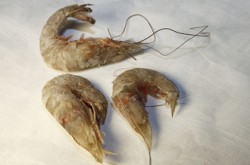Divetalking » Boats, Conservation, Dolphin, Earth, Featured, Fish, General Question, ocean, Open Water, Reefs, Reference, Report, Shrimp » Gulf seafood deformities alarm scientists
Gulf seafood deformities alarm scientists
New Orleans, LA – “The fishermen have never seen anything like this,” Dr Jim Cowan told Al Jazeera. “And in my 20 years working on red snapper, looking at somewhere between 20 and 30,000 fish, I’ve never seen anything like this either.”
Dr Cowan, with Louisiana State University’s Department of Oceanography and Coastal Sciences started hearing about fish with sores and lesions from fishermen in November 2010.
Cowan’s findings replicate those of others living along vast areas of the Gulf Coast that have been impacted by BP’s oil and dispersants.
Eyeless shrimp
Tracy Kuhns and her husband Mike Roberts, commercial fishers from Barataria, Louisiana, are finding eyeless shrimp.
“At the height of the last white shrimp season, in September, one of our friends caught 400 pounds of these,” Kuhns told Al Jazeera while showing a sample of the eyeless shrimp.
According to Kuhns, at least 50 per cent of the shrimp caught in that period in Barataria Bay, a popular shrimping area that was heavily impacted by BP’s oil and dispersants, were eyeless. Kuhns added: “Disturbingly, not only do the shrimp lack eyes, they even lack eye sockets.”
Some shrimpers are catching these out in the open Gulf [of Mexico],” she added, “They are also catching them in Alabama and Mississippi. We are also finding eyeless crabs, crabs with their shells soft instead of hard, full grown crabs that are one-fifth their normal size, clawless crabs, and crabs with shells that don’t have their usual spikes … they look like they’ve been burned off by chemicals.” 
On April 20, 2010, BP’s Deepwater Horizon oilrig exploded, and began the release of at least 4.9 million barrels of oil. BP then used at least 1.9 million gallons of toxic Corexit dispersants to sink the oil.
Read the rest of the story at Al Jazeera
© 2012, admin. All rights reserved.
Filed under: Boats, Conservation, Dolphin, Earth, Featured, Fish, General Question, ocean, Open Water, Reefs, Reference, Report, Shrimp








